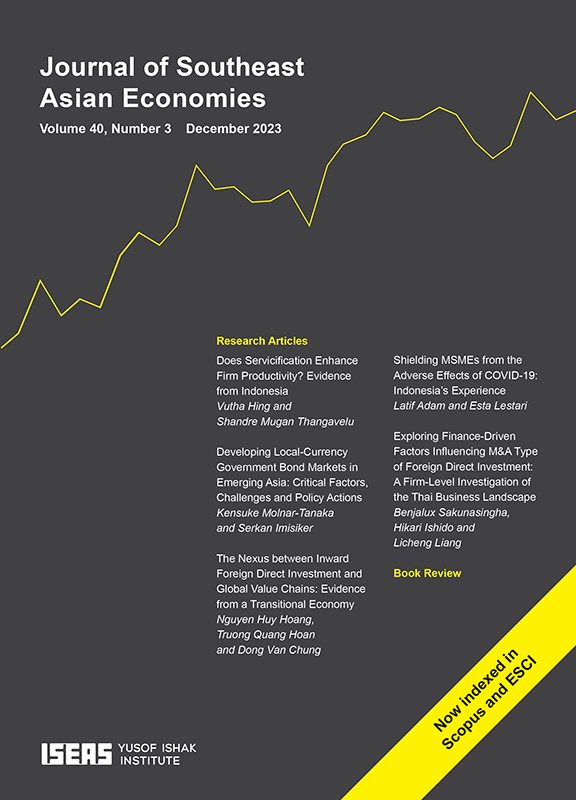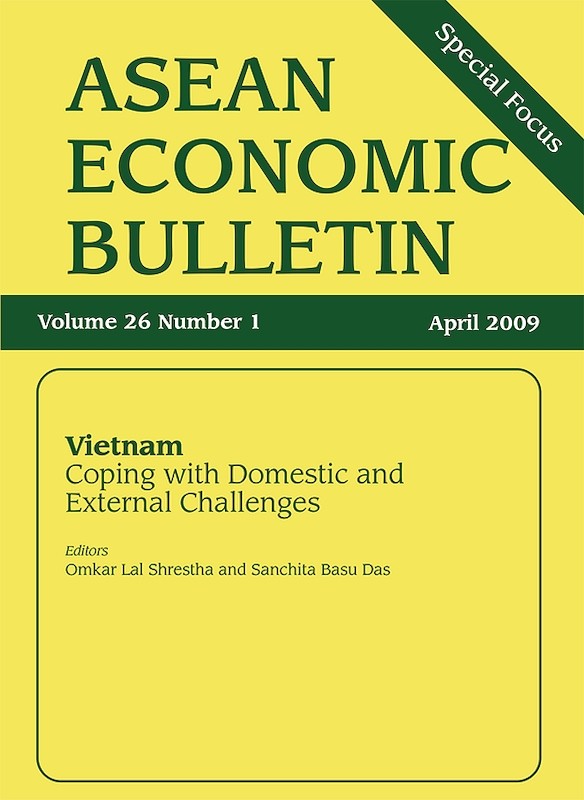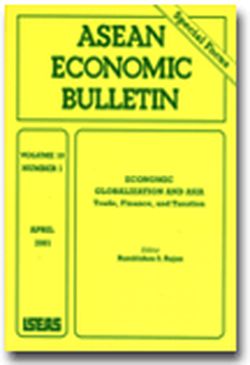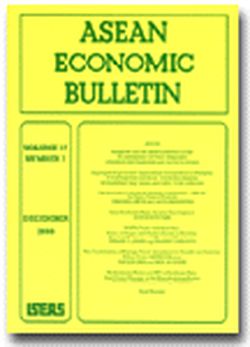ASEAN Economic Bulletin Vol. 28/2 (Aug 2011). Special focus on "Southeast Asia Beyond the Global Financial Crisis: Managing Capital Flows"

Date of publication:
August 2011
Publisher:
Institute of Southeast Asian Studies
Number of pages:
150
Code:
AE28/2
Contents
-
ASEAN Economic Bulletin Vol. 28/2 (Aug 2011). Special focus on "Southeast Asia Beyond the Global Financial Crisis: Managing Capital Flows"
[Whole Publication] -
Preliminary pages
- ARTICLES
-
1. Southeast Asia Beyond the Global Financial Crisis: Managing Capital Flows, by Jayant Menon, Aekapol Chongvilaivan, authors see abstractThe special issue of the ASEAN Economic Bulletin examines a number of policy issues relating to capital flows into Southeast Asia in the aftermath of the global financial crisis. The contributions to this volume address both thematic issues and country studies, examining a wide range of emerging issues relating to the influx of capital flows to the region. The findings and their policy implications offer insights into managing the impacts of crises in general and surges in capital flows in particular, as well as issues relating to post-crisis macroeconomic policy, currency realignment, and regional cooperation.
-
2. Foreign Direct Investment in Southeast Asia Is Malaysia Falling Behind?, by Prema-Chandra Athukorala, Swarnim Wagle, authors see abstractThis paper examines patterns and determinants of foreign direct investment (FDI) in Malaysia from a comparative Southeast Asian perspective. There is clear evidence that Malaysia's relative attractiveness for FDI within the region has eroded in recent years; outflow of FDI from Malaysia has consistently surpassed inflow of FDI, a pattern not seen in the other major Southeast Asian countries. The explanation seems to lie with the dualistic investment policy regime and the narrow domestic human capital base. We find no evidence that FDI in Malaysia (or major Southeast Asian countries) is crowded out by an increasing flow of FDI into China. On the contrary, Malaysia is well placed to benefit from a complementary FDI relationship with China as a favoured location of high-end tasks within global production networks.
-
3. Reducing Vulnerability in Transition Economies: Crises and Adjustment in Cambodia, by Hal Hill, Jayant Menon, authors see abstractThis paper examines the impact of the global financial crisis on Cambodia, and the lessons learned. Cambodia is an interesting case study: After extremely rapid economic growth during 2000-07, it experienced a sharp growth collapse in 2008-09. This highlighted a number of peculiar vulnerabilities, including a narrow economic base, a pre-crisis asset price boom, a fragile financial system, and the limited array of defensive economic policy levers available to the government. The economy has begun to rebound since early 2010, and the crisis episode provides the government with an opportunity to place the country's economic growth trajectory on a more sustainable footing. Apart from diversifying the economy and creating the preconditions for de-dollarization, we also consider policies that could improve the business climate and make growth more inclusive.
-
4. Back to Basics: Post-crisis Macroeconomic Rebalancing in ASEAN, by Molly Lesher, Michael G Plummer, authors see abstractThis article considers the policies that can help facilitate rebalancing in ASEAN economies. As the region moves away from policies to combat the effects of the global economic crisis, rebalancing growth becomes essential. Approaches to internal rebalancing, including shifts in current patterns of consumption and investment, as well as external rebalancing strategies, such as exchange rate adjustments and reducing trade costs, are explored as ways to diversify sources of growth. We also argue that regional cooperation, particularly on exchange rate and trade policy, is a key element of any concerted effort to ensuring sustained, long-term regional growth.
-
5. Does FDI Enhance Economic Growth? New Evidence from East Asia, by Polpat Kotrajaras, Bangorn Tubtimtong, Paitoon Wiboonchutikula, authors see abstractForeign direct investment (FDI) has increased rapidly in East Asian countries over the past two decades, and many studies find that it has significant linkages with economic growth. This paper examines the impacts of FDI in groups of 15 East Asian countries classified by level of economic development, using panel data analysis together with co-integration methods. The results show that favourable impacts of FDI on East Asian countries depend on complementary factors, particularly each host country's economic conditions such as levels of financial market development, institutional development, better governance, and appropriate macroeconomic policies. Furthermore, East Asian countries need to increase their investment in fundamental infrastructures, human capital development, and facilities for enhancing international trade and investment climate.
-
6. Is Capital being Pushed or Pulled into Southeast Asia?, by Thiam Hee Ng, author see abstractThe paper aims to examine if push or pull factors are driving capital inflows into Southeast Asia. Using factor analysis, we find that there is one common factor that is driving capital flows into the region. This common factor, which can be interpreted as a push factor, accounts for 35 per cent of the variance of capital inflows into the region. Regression analysis shows that the push factor is strongly influenced by investors' risk perception and, to a lesser extent, by business cycle in the United States. This is worrying as risk perception can change quickly during periods of crisis and the capital inflows could suddenly turn into outflows, as seen during the recent global financial crisis.
-
7. Foreign Investor Participation in Emerging East Asian Local Currency Bond Markets, by Sabyasachi Mitra, Roselle Dime, Anthony Baluga, authors see abstractEmerging Asian local currency bond markets have come a long way since the 1997/98 financial crisis and emerged as a distinct asset class. Foreign capital inflows into these markets have increased steadily in the past few years. This paper employs an econometric model to analyze the determinants of foreign investor participation in local bond markets. It concludes that foreign participation in local bond markets is influenced by (i) return prospects (ii) market liquidity and (iii) size of the market.
-
8. Cross-listings and Financial Integration in Asia, by Tony Cavoli, Ron McIver, John Nowland, authors see abstractRecent literature suggests the extent of foreign listings (cross-listings) on domestic stock exchanges may be informative as a measure of financial integration. In this study, we present both stylized facts and panel data analysis examining relationships between the proportion of foreign listings and other measures of integration in a sample of Asian markets to determine if this form of cross-listing complements or substitutes for other aspects of integration. We find that higher trade openness, higher output growth and lower inflation are associated with a greater proportion of foreign listings. In addition, we find that FDI openness has a negative relationship to the proportion of foreign listings, suggesting that these aspects of financial integration are substitutes. For policymakers, our results indicate that unless the appropriate financial liberalization policies are in place, countries may find it difficult to simultaneously attract foreign listings to enhance development of their stock market and to grow their real economy through FDI.






